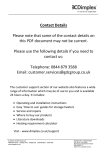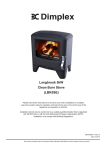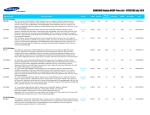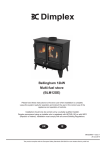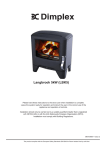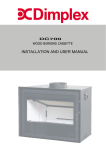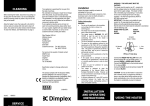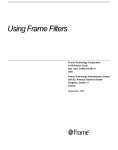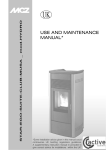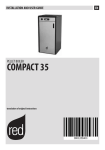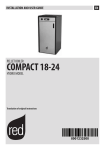Download Dimplex Bellingham 5kW BLM5SE Operating instructions
Transcript
Bellingham 5kW
Multi-fuel stove
(BLM5SE)
Please hand these instructions to the stove user when installation is complete.
Leave the system ready for operation and instruct the user in the correct use of the
appliance and operation of controls.
Installation should only be carried out by a suitably qualified installer.
Dimplex recommend using an installer who is registered with HETAS (UK) or with INFO
(Republic of Ireland). Installation must comply with all current Building Regulations.
UK
IE
08/52386/0 - Issue 1
29 May 2014
The product complies with the European Safety Standards EN13240 for room heaters fired by solid fuel.
-2-
B
1
F
C
D
K (Dia)
H
G
A
J
I
E
Table 1 - Dimensions
A
B
C
D
E
F
G
H
I
J
K
Bellingham 5kw
596
466
35
233
120
368
70
140
195
465
127
Note: All Dimensions in mm. Dimensions stated may be subject to a slight ± variation. ( 25.4mm = 1”)
Table 2 - Technical Specification
Bellingham 5kw
Wood
kW
5.0
Solid Fuel (Ancit)
kW
4.9
Wood
%
84.8
Solid Fuel (Ancit)
%
85.0
Wood
%
0.34
Solid Fuel (Ancit)
%
0.33
Wood
°C
210
Solid Fuel (Ancit)
°C
215
Wood
g/s
3.3
Solid Fuel (Ancit)
g/s
2.9
Refuel Period
hr
1
Safe Distance to Combustibles
mm
Flue Outlet Size
mm / inch
Product Weight
kg
Additional Room Ventillation Required
cm²
Nominal heat output
Efficiency
CO Emission (@13% O2)
Flue Gas Temp
Flue Gas Mass Flow
2
A
see table 5
127 / 5
71.8
see table 4
3
x4
Boost/
Refuel
Max
Min
+
Solid Fuel
Burning
_
Max
+
Wood
Burning
-3-
4
5
Solid, non-combustible
material e.g. masonary
or concrete
H
T
See Table 3
T
MIN m
m
150
X
mm
0
30
X
MIN
150mm
MIN
125mm
X
Table 3 - Position of Hearth & Appliance from adjacent walls
Hearth distance ‘X’ from wall
Appliance distance from walls
Min Wall Thickness ‘T’
Min Wall height ‘H’
0 - 50mm
200mm
Height of appliance +300mm
or 1200mm from hearth
(whichever is greater)
0mm
0mm
51 - 150mm
75mm
0 - 150mm
150 - 300mm
75mm
+150mm
+300mm
No Minimum Requirement
6
7
Fire proof seal
or fire cement
150
150
150mm Max
150
MIN 840mm
300
FREESTANDING ON
NON COMBUSTIBLE HEARTH
MIN 12mm THICK
MIN 840mm
45°
Max
-4-
8
9
Fire proof seal
or fire cement
150mm max
SEAL
150mm max
10
11
C
A
B
CLOSURE
PLATE
Bellingham 5kW (BLM5SE)
-5-
IMPORTANT: THESE INSTRUCTIONS SHOULD BE READ CAREFULLY AND RETAINED FOR FUTURE REFERENCE
Important Safety Advice
Please read these instructions carefully before installing
or using this appliance. Failure to do so may result in
damage to persons and property.
Installation of this appliance must be carried out by a
suitably qualified competent person in accordance with
all Building Regulations, including those referring to Local
Authority Bye-Laws, National and European Standards
and Codes of Practice.
Do not install this appliance on a shared flue.
Do not fit an extractor fan in the same room as this
appliance.
Ensure that there is adequate ventilation in the room in
accordance with building standards. Do not obstruct any
of the air inlets or outlets on the appliance.
A flue damper should not be fitted when burning solid
fuels other than wood.
This appliance operates at very high temperatures and
retains its heat for a period after use. Do not touch any
surfaces while in use. All persons including children and
the infirm should be warned of this and not allowed to
touch any surfaces while in use. Please use a suitable
fireguard to prevent contact when in use.
Do not place any photographs, paintings, TV’s or other
combustible items near the appliance as exposure to
hot surfaces will cause damage. Maintain safe distances
from combustible materials in accordance with these
instructions – please refer to Table 5.
The operator must use the tools provided. The glove
provided is a tool.
This appliance is for domestic heating use only in
accordance with these operating instructions. Do not
make any unauthorised changes to the appliance.
Do not burn petroleum coke fuels, household waste or
plastic in this appliance.
Burn only fuels with a low moisture content, such as
smokeless fuel or properly seasoned wood. Burning soft
or wet fuels such as unseasoned timber or peat will only
result in a build up of tar in the stove and the chimney
and will cause staining of the glass.
Do not use flammable liquids to ignite the fire.
Avoid the use of aerosols in the vicinity of the stove when
it is in operation.
Clean your chimney at least twice a year and check the
baffle plate monthly to ensure there are no blockages. Do
not allow a build up of ash to occur in the ash pan as this
will cause the grate to burn out prematurely.
Regular maintenance should be carried out by a suitably
qualified engineer.
Health and Safety Precautions
Handling: This product is heavy and should be handled with care
to avoid the possibility of personal injury when moving or servicing.
Adequate facilities must be available for the unloading and handling
of this appliance. Use protective clothing.
Fire Cement/Glue: Some types of fire cement/glue are caustic
and should not be allowed to come into contact with the skin. Use
suitable protective gloves when handling. In case of contact, wash
immediately with plenty of water.
Asbestos: This appliance contains no asbestos. If there is a
possibility of disturbing asbestos as a result of installation then
specialist guidance must be sought prior to installing.
Installation Instructions
General
These instructions give a guide for the installation of the stove but
in no way absolves the installer from responsibilities to conform
to all relevant standards relating to the installation of solid fuel
appliances.
We recommend that for UK installations a HETAS registered
installer should be used, who will be able to give a Certificate of
Compliance that installation complies with Building Regulations.
In Ireland a registered installer from the Irish Nationwide Fireplace
Organisation should be used.
Please note that to the best of our abilities these instructions are
correct at time of printing, however we cannot be held responsible
for any differences in legislation which may occur in the future.
Assembly of the stove
The stove is bolted to the crate by the legs to prevent damage
during transportation. Unscrew the fixing bolts (see ‘A’ Fig 2) to
release the crate before placing the stove in the desired location.
The bolts can be re-used to stabilise the product for uneven floors.
To make the product easier for handling on installation, remove
the liner bricks, baffle plate, grate bars and ashpan. Place these
in a secure place to avoid damage. These must be refitted after
installation.
The stove is supplied ready for top flue connection. For rear flue
connection, rearrange the flue cap, gasket and collar arrangement
as shown (Fig 4). The punch-out section on the heat shield will
need to be removed using shears for rear flue connection. Tighten
all fixing screws are to ensure parts are airtight.
Chimney & Flue Connections
The stove may be connected to an existing chimney or a relined
chimney using a flue pipe made of cast iron, 316 grade stainless
steel or vitreous enamelled steel, nominal thickness 1.2mm. The
diameter of the steel flue pipe should be 125mm (5”) minimum.
Before installing on an existing clay chimney, check that it is in good
condition; dry and free from cracks and obstructions. The diameter
of any existing clay flue should not be less than 150mm and not
more than 230mm. If these requirements are not met, the chimney
should be relined by a suitable method by a qualified person.
The chimney height and the position of the chimney terminal should
conform to Building Regulations. If you have any doubts about the
suitability of your chimney, consult your local dealer or stockist.
The chimney must be swept thoroughly before connection to the
stove and swept every six months thereafter.
If there is no existing chimney then a prefabricated block chimney
or a twin walled insulated stainless steel flue to BS4543 can be
used. These must be fitted in accordance with the manufacturers
instructions and in compliance with Building Regulations.
-6-
Connect the flue pipe to the stove making sure that it fits snugly
into the base of the flue collar . Seal the collar and flue connection
with fire cement or with other suitable high temperature sealant.
Add flue sections as required; note that all flue sockets must face
upwards. Ensure that the flue pipe end is no closer than 76mm
to the side or rear of the chimney walls. It is essential that all
connections between the stove and the chimney flue are sealed
and made airtight.
Avoid using bends greater than 45° to the vertical (Fig 7). All flue
pipes should be as close to vertical where possible. For rear flue
connection the length of the horizontal run of the flue pipe should
not exceed 150mm (Fig 8). Both chimney and flue pipe must be
accessible for cleaning and if ALL parts of the chimney cannot
be reached, a soot door must be fitted to enable this to be done.
This product must not be installed on a shared flue.
Flue Draught
The chimney should be checked before the stove is installed to
ensure that there is adequate flue pull. The draught can be checked
initially by using a smoke match close to the flue opening. If the
chimney doesn’t pull the smoke it may suggest that the chimney
needs further attention. Any remedial work to the chimney flue
should be carried out by a suitably qualified engineer.
A flue draught of minimum 12 Pascal to maximum 25 Pascal is
required for satisfactory appliance performance. The flue draught
should be checked under fire at high output and if it exceeds the
recommended maximum a flue draught stabiliser (or flue damper
as it is also known) must be fitted so the rate of burning can be
controlled and prevent overfiring.
Flue Damper (Not Supplied)
When burning wood, a flue damper may be fitted to reduce the
draught through the stove if the draught is too high. When the
damper is set in the open position the chimney draws at full
draught, increasing the volume of air flow through the stove and
flue. Shutting the damper restricts the flow, slowing the rate of
burning. The damper should be fitted to the stove flue and should
be the same size as the flue pipe. As a rule it should be fitted no
closer than 700mm from the flue outlet of the appliance.
A flue damper should not be fitted when burning solid fuels
other than wood.
Room Ventilation
For safe operation this stove must be provided with combustion
air supply in addition to normal room ventilation, in accordance
with Building Regulations. Minimum ventilation requirements vary
depending on whether the dwelling is considered to be of standard
construction or of airtight construction, or if a flue draught stabiliser
has been fitted. The required open air vent sizes are as follows:
Table 4 - Additional Room Ventilation Required
Standard build dwellings {air permeability >5.0m³ /(h.m²)}
No Flue Stabiliser
No additional vent required
With Flue Stabiliser
15 cm²
Airtight build dwellings {air permeability ≤5.0m³ /(h.m²)}
No Flue Stabiliser
27 cm²
With Flue Stabiliser
42 cm²
The stove may be connected to a dedicated combustion air supply
using the air duct at the rear of the stove (see ‘X’ Fig 4). Connection
can be made to an external wall vent using standard 4” flexible
aluminium ducting. Plastic ducting must not be used.
An extractor fan must not be used in the same room as this
appliance.
Floor Protection & Installation Clearances
In all instances the stove must be positioned on a non-combustible
hearth that conforms to Building Regulations and is firm, secure
and capable of supporting the stove. Care should be taken to
ensure the stove is level.
The stove can be installed in suitably sized recess, either purpose
built or an existing fireplace. In this instance Building Regulations
require that a solid constructional hearth of minimum 125mm must
be used, including the thickness of the floor and any decorative
top surface (e.g. tiling). We recommend a minimum air circulation
space of at least 150mm around the sides and rear and 300mm
above the top to obtain maximum heat output and for access to
the rear of the stove.
Building regulations stipulate minimum wall clearances for stoves
from adjacent walls and constructional hearth (Table 3 & Fig 5).
The stove can also be installed freestanding in the room. In this
instance a reduced thickness hearth may be used, which must
be made from non-combustible board, sheet or tiles of minimum
thickness12mm. (Fig 6) shows the minimum distances required
from the hearth edge to the sides of the stove.
In all cases allow an apron of at least 300mm at the front of the
stove in case of spills when de-ashing.
Table 5 shows the minimum safe distances to combustable
materials which must be observed in all installations. Any
surrounding combustible material should not exceed 80°C.
Table 5
Sides
Rear
Bellingham 5kW
500mm
250mm
Existing Fireplace
An existing fireplace opening can be bricked up or sealed with a
register plate, 2.5mm sheet steel or concrete. A short length of
flue pipe may then be used to connect the stove to the chimney.
Ideally the old fireplace should be filled in so that there is a smooth
streamlined entry into the flueway. (Fig 8)
Typical installation for Inglenook Fireplaces
Inglenook fireplaces can have very large bore chimneys (Fig 9).
Check with your installer – you may need a stainless steel flexible
flue liner for solid fuel fitting.
Commissioning
Upon completion of installation, the stove and flue system should
be tested by a suitably qualified person to make sure it is safe for
normal use. A smoke draw test should be completed to check for
soundness of joints and seals and also that all smoke and fumes
are taken from the appliance up the chimney and emitted safely.
First warm the flue with a blowlamp or similar for about 10 minutes.
Place a lit smoke pellet on the centre of the grate with the air
controls open. Close the door – the smoke should be drawn up the
flue and be seen to exit from the flue terminal. Complete the test
with all windows and doors shut in the room where the appliance
is fitted.
If a ceiling fan is present it must be operated on max for the duration
of the test. If there are any extraction fans in adjacent rooms these
too must be operated on maximum setting during the test with the
interconnecting doors open. If any spillage occurs, recheck the
suitability of the flue system making sure there is adequate air
supply to the room (as per Building Regulations).
Light the appliance and slowly increase the temperature to
operating levels. Open the main fire door when the appliance
reaches normal operating condition and carry out a spillage test
using a smoke match or pellet around the door opening. If any
spillage occurs, open all windows, allow the fire to go out and
recheck the flue system and ventilation.
-7-
Operating Instructions
baffle plate. The stove must not be operated with the door left open.
Warning: This appliance and its operating handles become
hot when the stove is in use and for some time afterwards.
For your safety use the glove provided.
The stove is not suitable for overnight burning, however it can be
banked up to burn for extended periods. Before refuelling, empty
the ashpan, especially when burning solid fuel. Open air controls
and let the fire burn brightly for a short period before reducing air
supply; the exact setting required will depend on the fuel used and
the chimney draw so some practice may be necessary. To revive
the fire, open air supply until the fire is burning brightly, de-ash if
necessary and refuel. Set air controls as required.
Initial Firing of Stove
Please note that the stove paint and fire cement cures during the
inital firing period. Upon first lighting, smoke may rise from the
surface of the stove as the paint cures and this can give off a strong
smell, however this is quite normal. The room must be left well
ventillated during the running in period until any smells dissipate.
We suggest that you vacate the room during this period checking
on the stove periodically. If necessary an air circulation fan may be
used to facilitate air movement and remove any odours.
Start by lighting a small fire, then gradually build the fire until you
reach the maximum output for a period of 2-3 hrs. This is to ensure
that the paint and fire cement cures fully. If with the first lighting
the maximum temperature is not reached, the above mentioned
effects may arise later on. Always build the fire gradually as this
allows castings to relax and consolidate location, especially after
long idle periods when the stove has not been in use.
Air Controls
The stove heat output is controlled using the air slide below the
door (see Fig 3). For wood burning the slide should be operated
to the right. When burning solid fuel the slide should be moved to
the left. In both instances the minimum burn position is when the
slide is in the central position. The further the slide is moved from
the centre position the more air will be supplied to the fire and the
greater the heat output for either wood or solid fuel burning.
The door is opened by turning the handle anti-clockwise as shown
(B - Fig 10). To lock the door, turn handle clockwise when closed.
Lighting the Stove
Before lighting the fire check that the grate is set in the correct
position for the fuel you are burning and that the stove has been
de-ashed fully. When burning wood only the grate bars may be
left in the flat position with the grate arm pushed in (see C - Fig
10). When burning solid fuel or mixed fuel types the grate bars
must be in the upright position with the grate arm fully extended.
Place fire lighters or paper and 5-6 pieces of dry kindling on the
grate. Light the fire at base and allow the kindling to light fully
across the grate. Build the fire up gradually using small refills of
fuel until there is a good fire bed and the fire is well established.
When refuelling leave the air control in the boost position fully to
the right for wood burning (as shown Fig 3). If refuelling with solid
fuel move the slide fully to the left position for maximum undergrate
air. Once the fuel is alight reduce back the air supply to the desired
output. Do not refill the stove above the level of the rear brick.
Running the Stove
When your fuel is well alight you can start to restrict the air intake to
the desired setting. Your stove is burning with maximum efficiency
when a bright fire is achieved using minimum air inlet.
Never leave the stove unattended until the logs are burning well
and the air supply has been adjusted down to desired level.
Note that refuelling onto a low firebed causes excessive smoke
to occur. Refuelling must be carried out onto a sufficient quantity
of glowing embers to ignite fuel in a reasonable period. If there
are too few embers add kindling first to get fire going again before
refuelling.
For optimum performance the stove should not be overfilled with
fuel above the height of the rear brick, ideally the top 1” height of
the rear brick should be visible at all times. Overfilling can cause
poor operation, excessive smoke to occur and possible damage to
Notes on Wood Burning
Burn only dry, well seasoned wood, which should have been cut,
split and stacked for a minimum of 12 months (24 months is better)
with free air movement around all sides of the stack to enable it to
dry out. Burning wet or unseasoned wood will create tar deposits
in the stove and chimney and will not produce a satisfactory heat
output. When loading wood, make sure that the end grain of the
wood in the stove is pointing away from the glass otherwise the
moisture and gases coming from the end grain of the wood will
dirty the glass.
Table 6 - Maximum log lengths
Bellingham 5kW
350mm (14”)
Notes on Solid Fuel burning (Other than Wood)
Always de-ash the stove before burning solid fuel and do not let the
ash build up to the underside of the grate bars. If ash is allowed to
build up it will stifle the air flow through the grate and will eventually
cause the fire to die. Air passing through the firebed cools the
grate. Distortion or burning out of the grate bars is nearly always
caused by ash being allowed to build up on the underside of the
grate. With some solid fuels a residue of burnt fuel or clinker will
accumulate on the grate. It is important it is to empty the ash pan
and remove clinker after each firing of the stove.
We recommend the use of HETAS approved manufactured
smokeless fuels. Note that different types of fuel will give different
performances. Using the stove as an incinerator for household
waste invalidates the warranty is not recommended as fumes from
plastic, etc will cause pollution to the atmosphere and will cause
damage to the stove.
Petroleum coke fuels, bituminous (smokey) coal or household
waste should not be burned on this appliance.
De-Ashing
To de-ash the grate draw the riddle lever in and out using the hand
tool provided, with a slow positive action (C - Fig 10).
The ash pan should be emptied each time after operating the
stove so not to let build up of ash occur. For efficient burning of
your appliance, make sure the grate is clear of unburnt debris;
e.g. nails, etc. It is best to wait until the stove and ash has cooled
before removing the ash pan. To remove, open the stove door by
turning the handle anticlockwise (B - Fig 10) then using the hand
tool lift the ash pan out of the fire (Fig 11). Allow the ash to cool
fully before disposing in a bin.
Shut down Periods
If shutting down the stove for long periods (e.g. for summer months)
make sure that all ash is removed from the stove and that the
chimney flue ways and baffle plate are brushed clean. When the
stove is cold a vacuum may be used to remove any residual ash or
soot. Close the door and leave the air control in the boost position.
This action will ensure air circulation through the appliance and
will help to avoid corrosion and condensation within the appliance
during this shut down period.
-8-
Safety Notes for Your Guidance
FIRES CAN BE DANGEROUS.
Always use a fire guard in the presence of children, the elderly
or the infirm. Inform all persons the dangers of high temperatures
during operation of the appliance including the stove pipe.
Use operating tools provided.
DO NOT OVER FIRE.
It is possible to fire the stove beyond its design capacity. This could
damage the stove, so watch for signs of over firing. If any part of
the stove starts to glow red, the stove is in an over fire situation
and the controls should be adjusted accordingly to reduce air
intake. Never leave the stove unattended for long periods without
adjusting the controls to a safe setting. Careful air supply control
should be exercised at all times.
Warning - Fume Emissions
Properly installed and operated, this appliance will not emit fumes.
Occasional fumes from de-ashing and refuelling may occur.
Persistent fume emission must not be tolerated. If fume emission
does persist, then the following immediate action must be taken:
1. Open doors and windows to ventilate the room.
2. Let the fire out, or eject and safely dispose of fuel from the
appliance.
3. When the stove has cooled, check for chimney flue blockage
and clean if required.
4. Do not attempt to relight the fire until the cause has been
identified. If necessary seek professional advice.
General Maintenance
Baffle Plate: This should be removed at least once a month to
prevent any build up of soot or ash, which could lead to blocked
flue ways and dangerous fume emission. This must be done when
the stove is cold. Once the baffle plate is removed the chimney/
flueway can be swept through the appliance.
The baffle plate holds the side bricks in position and uses two
extended tabs to locate on top of the bricks while the rear edge
rests on the tertiary air bar. To facilitate easy removal the log bar
can be removed by unscrewing the transport fixing bolt on the
underside (It is not necessary to refit this bolt for normal stove
operation). Please note the baffle plate position before removal.
To remove the baffle plate, lift the front edge and slide it forwards
until it drops down clearing the front edge of the side bricks.
The rear of the plate should now clear the back brick & airwash.
Holding the plate in horizontal position, carefully rotate the baffle
plate clockwise until the tabs on the lower side becomes free. The
bottom side can then be pulled forward from the side brick and the
plate can be removed.
Stove Body: The stove is finished with a heat resistant paint and
this can be cleaned with a soft brush. Do not clean while the stove
is hot, wait until it has cooled down. The finish can be renovated
with a suitable brand of stove paint.
Glass Panels: Clean the glass panels when cool with a proprietary
glass cleaner or some damp newspaper. Do not use abrasive
materials as these can scratch the glass and make subsequent
cleaning more difficult. Wet logs on heated glass, a badly aimed
poker or heavy slamming of the doors could crack the glass panel.
The glass should not fracture from heat.
Chimney: Check your chimney each year before starting to use
your stove for the winter. Birds may have nested in the chimney
or masonry may have cracked. Both chimney and flue pipe must
be swept at least once a year by a Qualified Chimney Sweep.
Troubleshooting
1. Poor heat output
a. Stove too small for room: Seek advice from a Qualified Heating
Engineer as to (kW) output required for the room size. As a
guideline the volume of the room in cubic feet divided by 500;
e.g. room 15’x15’x8’ would require 3.6kW approx.
b. Chimney and/or flue pipe restricted, room ventilation restricted:
On installation these should have been checked but regular
maintenance is necessary as conditions can change; e.g. soot
build up, birds nesting, masonry fall, dust build up or furniture
blocking vents.
c. Poor quality fuel: Only burn dry seasoned timber, soft woods
have a lower heat output than hard woods per hour. Solid
fuels vary in heat value; check with your coal merchant as to
suitability.
2. Dirty Glass Panel
a. Generally caused by poor fuel quality, damp fuel or burning
wood that has not been properly seasoned.
b. Airslide not in correct position for the fuel type, e.g. on solid fuel
setting when burning wood.
c. Fire burning too low, open air vents on stove to create hot fire;
this may ‘burn’ glass clean.
d. If glass requires cleaning use glass cleaner recommended by
your supplier; only use glass cleaner on cold glass. DO NOT
USE any abrasives or scrapers as these will scratch glass and
increase future tar build up making it harder to clean.
3. Unburnt Fuel in Firebox
Insufficient air reaching fuel causing it to go out. Open the air
slide, this will supply combustion air to burn fuel fully (unless it
has insufficient heat to ignite or has already extinguished). Check
if the ash pan is full and empty if required. De-ash to make sure
the grate is not blocked and check for jammed clinker or nails
when the fire is out and the stove has cooled. A small amount of
unburnt clinker is normal after the fire has extinguished and the
amount left is dependent on fuel type.
4. Smoke and Fumes Entering Room
These are very dangerous and must NOT be tolerated. Open
window and allow fire to burn out. Seek expert advice immediately.
DO NOT USE stove until the problem is solved.
5. Chimney Fire
Identified by loud roaring sounds, dense smoke and sparks emitting
from chimney. Shut down the air supply by closing air vents, close
stove door fully and call fire brigade immediately.
Chimneys must be swept at least once anually, more frequently if
smokey fuels are used. Regular chimney maintenance will prevent
chimney fires. Seek advice from a Qualified Chimney Sweep.
-9-
The Clean Air Act 1993 and Smoke Control Areas
Under the Clean Air Act local authorities may declare the whole
or part of the district of the authority to be a smoke control area. It
is an offence to emit smoke from a chimney of a building, from a
furnace or from any fixed boiler if located in a designated smoke
control area. It is also an offence to acquire an “unauthorised fuel”
for use within a smoke control area unless it is used in an “exempt”
appliance (“exempted” from the controls which generally apply in
the smoke control area).
The Secretary of State for Environment, Food and Rural Affairs
has powers under the Act to authorise smokeless fuels or exempt
appliances for use in smoke control areas in England. In Scotland
and Wales this power rests with Ministers in the devolved
administrations for those countries. Separate legislation, the Clean
Air (Northern Ireland) Order 1981, applies in Northern Ireland.
Therefore it is a requirement that fuels burnt or obtained for use
in smoke control areas have been “authorised” in Regulations
and that appliances used to burn solid fuel in those areas (other
than “authorised” fuels) have been exempted by an Order made
and signed by the Secretary of State or Minister in the devolved
administrations.
The Bellingham 5kW stove has been recommended as suitable for
use in smoke control areas when burning wood and manufactured
smoke less fuels. The air control has been set to ensure a minimum
burn rate for clean burning during operation.
Further information on the requirements of the Clean Air Act can
be found here : http://smokecontrol.defra.gov.uk/
Your local authority is responsible for implementing the Clean
Air Act 1993 including designation and supervision of smoke
control areas and you can contact them for details of Clean Air
Act requirements
After Sales Service
As a sign of our commitment to quality, all new Dimplex solid
fuel stoves are guaranteed against casting faults and other
manufacturing defects for 10 years in the case of non-boiler
stoves and 5 years in the case of boiler models, subject to certain
conditions and exclusions. The guarantee covers the main body
of the stove and external cast parts under normal domestic use
- it does not cover use in commercial premises. The guarantee
period begins on the date of purchase. The guarantee covers
replacement of the parts found to be defective but does not cover
labour charges.
Conditions and Exclusions:
The guarantee does not cover the following items which are
deemed to be consumable items under normal use: glass, rope
seals, grate, ashpan, cast iron liners, riddling lever, baffle plate,
fire bricks and log retainer.
It is a condition of the guarantee that the installation complies
with relevant Building Regulations and is carried out by a suitably
qualified individual (HETAS registered in England and Wales, or
equivalent in other countries) with certificate of installation and
appropriate commissioning retained by the end-user along with
proof of purchase.
Whilst the guarantee does not cover any aspect of the flue
arrangements for the installation, or the installation work itself, as
these are beyond the control of Dimplex as the manufacturer of
the stove, it is a condition of the guarantee that the flue be swept
by a suitably qualified individual as appropriate but at a minimum
interval of once per year. It is expected that the stove would be
inspected for developing faults at the time of sweeping to allow
any necessary maintenance to be carried out.
Damage or defects caused by the following are excluded: overfiring, use of inappropriate fuels such as petroleum coke or
household rubbish, flue draft problems, ventilation issues, accident,
misuse, fair wear and tear, unauthorised modifications or repairs
made using incorrect spares.
In normal usage the paint finish of the stove may change colour
slightly or lighten in shade over time. This is considered normal and
is not covered by the guarantee. Damage caused by over-firing is
excluded from the guarantee.
It is a condition of the guarantee that only genuine Dimplex spare
parts are used. Parts that may need occasional replacement are
fire bricks, ashpan, grate and log retainer. NB: sealing rope and
rope adhesive are generic stove spares that can be purchased
from most stove retailers. Provided the rope seals are replaced
like for like and fixed with appropriate stove rope adhesive, this
will not invalidate the guarantee.
Genuine Dimplex spare parts are available in the UK direct from
the manufacturer and can be ordered via www.dimplex.co.uk or
by telephone on 0845 600 5111. For Republic of Ireland orders
see www.dimpco.ie or Tel: 01 842 8222
Dimplex reserves the right to provide either replacement parts or
a replacement stove, at their sole discretion, in order to satisfy
claims made under this guarantee.
Replacement parts or stoves are covered only for the remainder
of the original guarantee period.
Dimplex will not be held responsible for any consequential or
incidental loss, damage or injury, howsoever caused.
The Dimplex stove guarantee does not affect, and is in addition
to, your statutory rights.
Should you require after sales service or should you need to
purchase any spares, please contact the retailer from whom the
appliance was purchased. Please do not return a faulty product
to us in the first instance as this may result in loss or damage and
delay in providing you with a satisfactory service. Please retain
your receipt as proof of purchase.
- 10 -
- 11 -
Bellingham 5kW (BLM5SE)
7
8
10
9
11
12
13
3
14
15
2
6
16
1
17
4
5
18
19
21
20
BELLINGHAM 5KW STOVE (BLM5SE) - SPARE PARTS
Item
Description
Part Number
Item
Description
Part Number
1
DOOR
1/70099/0
13
GRATE BAR
1/70420/0
2
HINGE
1/70095/0
14
BAFFLE PLATE
1/70108/0
3
DOOR PIN
1/70188/0
15
LINER BRICK PACK (2xREAR, 2xSIDE) 3/23128/0
4
DOOR HANDLE ASSEMBLY
4/19089/0
16
GRATE FRAME
1/70421/0
5
DOOR CATCH
1/70181/0
17
RIDDLE ARM
1/70422/0
6
DOOR GLASS
1/70100/0
18
AIR CONTROL HANDLE
1/71035/0
7
GLASS FIXING BKT
1/70101/0
19
LEG
1/70096/0
8
AIRWASH DEFLECTOR
1/70132/0
20
ASHPAN
1/70182/0
9
TERTIARY AIR BAR
2/61929/0
21
HAND TOOL
1/70186/0
10
FLUE COLLAR
1/70097/0
11
FLUE GASKET
1/70843/0
12
LOG BAR
1/70423/0
Great Britain:
GDC Group Ltd
Millbrook House
Grange Drive
Hedge End
Southampton
SO30 2DF
Northern Ireland:
Glen Dimplex Northern Ireland
5 Charlestown Avenue
Charlestown Industrial Estate
Craigavon
Co. Armagh
BT63 5ZF
Republic of Ireland:
Dimpco Ltd
Old Airport Road
Cloghran
Co Dublin
Ireland
t
f
e
w
t
f
e
w
t
f
e
w
+44 (0)844 879 3588
+44 (0)1489 773050
[email protected]
www.dimplex.co.uk
+44 (0) 2838 337 317
+44 (0) 2838 350 208
[email protected]
www.glendimplexni.co.uk
+353 (0) 1842 8222
+353 (0) 1842 4943
[email protected]
www.dimpco.ie
[c]A Division of GDC Group Ltd.
All rights reserved. Material contained in this publication may not be reproduced in whole or in part, without prior permission in writing
of GDC Group Ltd.












